Hidden Arches: The Gateway To Mastery
By Jeff Brooks
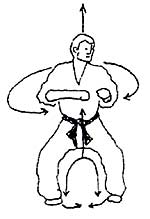 What if your entire body could act as a super-sensitive antenna? What
if you could perceive your opponent’s intention and contact everywhere
on your body and respond without any reaction time at all? What if your entire body could act as a super-sensitive antenna? What
if you could perceive your opponent’s intention and contact everywhere
on your body and respond without any reaction time at all?
As we begin martial arts training we acquire new techniques. But as
we mature as practitioners we are concerned as much or more with changing
the deep constitution of the body.
Whether you are a practitioner of tai chi, aikido, kendo or karate,
this is a fundamental concern of advanced training and no mater how many
advanced techniques you have memorized, until your body and mind transform
deeply, you will not be able to deploy the skills you have learned with
true mastery. Everyone can achieve this. It just takes consistent practice
and an understanding of what you are going for.
As advanced practitioners we are learning to unify the body. Transforming
what we experienced as beginners as the “parts” of the body
into a unified system of “arches.” Like arches in architecture,
experiencing the body in this way allows incoming pressure to be distributed
over the entire structure of the body, from head to toe, so that the
perception of the opponent’s incoming force is not localized at
the point of contact, but sensed by the entire body. This allows an immediate
adjustment in response, instead of a delayed reaction.
The change in the way we experience the structure of our body from beginner
to advanced is similar to the change in architecture from the Greek to
the Roman period. The Greeks created structures using columns for vertical
support, spanning them with cross beams.
|
The amount of material
needed to support a given load or to enclose a given amount of
space was very high. The load
limit of
this structure – the
amount of weight it could support – depended upon what is called
the “compression strength” of the material the column
was made of.
|
With a stone column it was very strong -- as long as the stress was
applied from the top down. If you stress columns from the side, or from
an angle, stressing the joint of the vertical and horizontal, the structure
is weak and unstable.
|
The genius of the Roman
arch (especially the hemispheric arch) was that it could support
an equal amount of vertical load using much
less material than the Greek method, because the arch distributes the
load over the entire span of the arch. They are even more stable, too,
because they can take load in many directions, not just the vertical.
|
As a beginning martial artist we learn to move by dividing the body
into parts and analyzing what to do with each part – move the foot
like this, turn that way, keep shoulders down, keep elbows in, the wrist
like this, the ankle like that… etc. This is a useful and necessary
stage of the process of learning to move skillfully. It is similar to
learning the alphabet before learning to read. But if we get stuck in
this thinking, if we take the body to be a collection of “parts,” we
will never appreciate the body’s coherence and immense ability.
With regard to various versions of the horse stance, for example, we
can see many practitioners use the “Greek” construction described
above: two legs as the vertical supports, the pelvis spanning them, joined
at the hips. If our body feels like that, it will function in a way that
is inherently weaker than its potential. The limit of that stance from
the vertical is in the muscles of the calves and quadriceps, and the
strength of the hip, knee and ankle joints.
You can transform it into a stance that is many times stronger, however,
if you know what to do. The amazing thing is you do not have to do years
of muscle building to effect the transformation – you just have
to think differently about what you are trying to achieve in your stance.
To do this you use the “Roman” approach to the structure
of the stance.
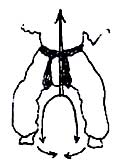 Instead of two legs as posts and the pelvis as a spanner, think of the
legs – from foot up through your hara (lower abdomen) to the other
foot – as a single arch. Bring the muscles into a fully arched
contraction by continuing the form of the arch through the floor – make
a full circle with your muscles, pulling the feet through the floor toward
each other, using the pelvis like the keystone in the arch. The butt
muscles, inner thigh adductors, the arches of the feet, the lower abdominals,
the lower back muscles all are part of this unified contraction which
creates the arch to support you in this stance. Instead of two legs as posts and the pelvis as a spanner, think of the
legs – from foot up through your hara (lower abdomen) to the other
foot – as a single arch. Bring the muscles into a fully arched
contraction by continuing the form of the arch through the floor – make
a full circle with your muscles, pulling the feet through the floor toward
each other, using the pelvis like the keystone in the arch. The butt
muscles, inner thigh adductors, the arches of the feet, the lower abdominals,
the lower back muscles all are part of this unified contraction which
creates the arch to support you in this stance.
There is no need to maintain high tension or rigidity in the body to
create arches, but it helps to get the feeling when you start to discover
them. Once you have the leg arch try this: extend your arms in a “square
punch and chambered fist” position. (I put that in quotes because
that hand position has numerous applications that have nothing to do
with a square punch or a chambered fist, but it is a convenient label
for the arm position.)
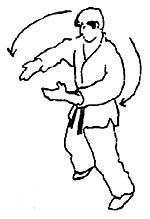 |
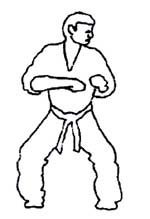 |
Arm arch |
Leg and arm arches together |
Now make your arms into an “arch.” Get the feeling that
instead of two separate levers hanging from your shoulders you have a
single unified system of energy running from fist, across your back (separate
the shoulder blades drawing the shoulders forward to get this feeling)
and continue the feeling of unbroken energy flow around to your other
fist. That is an arm arch.
Extend your spine in an erect vertical chain, feeling the small spaces
between the vertebrae, like the pulling up of a ballet dancer. That is
a spine arch.
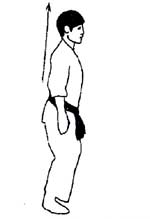 |
 |
Spine arch
|
Three arches of the body seen
together
|
When you start to make the body into arches, it is a conscious, labor-intensive
process. Just like learning your first basic techniques when you started.
But gradually it becomes natural. And instead of be a static, tight type
of feeling, it becomes more and more dynamic, and whip-like. A feeling
more like the resilience of bamboo than the rigidity of stone.
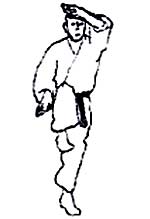 |
Myriad arches: splitting plus
knee strike, from the kata Rohai
|
Instead of having the body divided into three arches, the entire body,
little by little, is trained to perform as an integrated dynamic system
of numerous arches, with flows of energy moving as necessary.
This is essential work for advanced martial artists in any style. Using
push hands and a variety of our kata styles (from whipping ones to rooted
ones) we are developing the ability to unify the body in space (unifying
the parts of the body) and time (unifying movement sequences.)
We also unify the body and mind – deleting the time delay between
perception, will and movement. Also we can in a sense unify with or at
least harmonize with our opponent. As we get better at manifesting this “dynamic
arches” feeling in the body we can sense the opponent’s intention
and “read” his weak points and threatening points as we interact
with him.
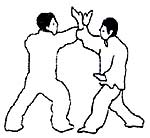 |
Push hands and kumite
|
|
This principle which we call arches
is part of a sophisticated system of movement and knowledge of
body architecture which was fundamental
to pre-modern karate. The enormous speed and power it allows you
to unleash is your own power. You have it now. Discovering it in
yourself is not just a thrill, but for the advanced martial artist – for
the 5 year practitioner who is looking for a new dimension, or for
those at the 10, 15 or 20 year mark who may have hit a plateau – it
marks the opening of immense potential in your practice that can
lead you to the gates of mastery. |
About The Author:
Jeffrey M. Brooks holds a Go Dan Fifth Degree Black Belt
in Matsubayashi Shorin Ryu, training in Okinawa, Japan and the USA with
Shoshin Nagamine, the founder of the style, Takayoshi Nagamine, his successor,
as well as numerous others in the Matsubayashi Ryu lineage and related
Chinese traditions. His Buddhist study and practice is with Rev. Issho
Fujita, resident director of Valley Zendo and Geshe Michael Roach of
the Asian Classics Institute. He has an M.F.A. from NYU Film School and
works as a speechwriter for public figures. He is founder and director
of Northampton Karate and Northampton Zendo in Northampton, Massachusetts,
offering classes daily for adults and children since 1988. (www.northamptonkarate.com).
Brooks’ column, “Zen
Mirror”, and other articles regularly
appear on FightingArts.com.
New!
FightingArts.com is pleased to announce its first
book: “Rhinoceros Zen –Zen
Martial Arts and the Path to Freedom,” by Jeffrey Brooks, a work
that portrays the dual paths and interplay between Zen and Karate-do.
Fast paced
and easy to read, it is full of insight and wisdom. It is a rewarding
read for any martial artist.
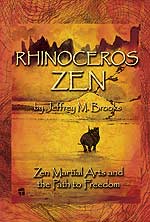
(Softcover, 300 pages, illustrated)
FAS-B-001

|
|